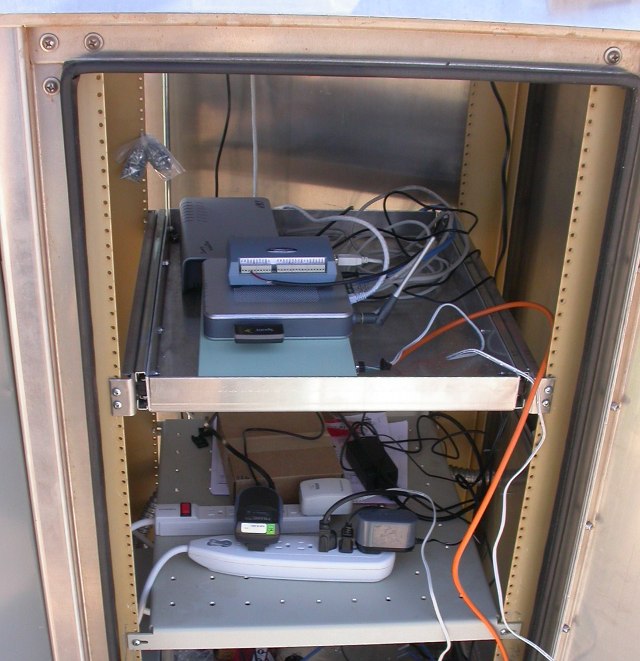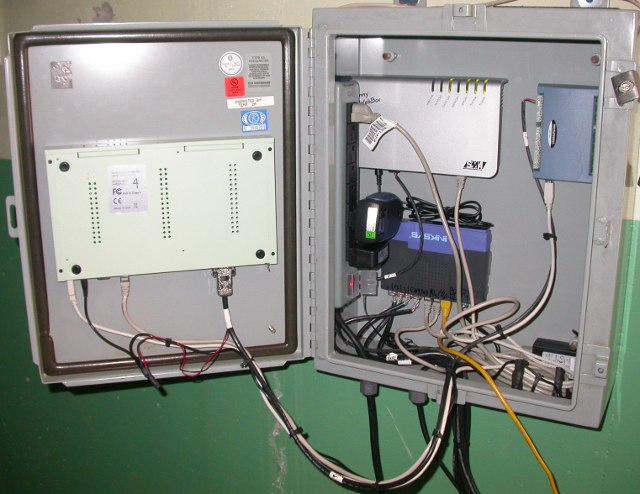Solar Control and monitoring hardware
Ordinarily, in a utility setting, this type of equipment would be called a SCADA (Supervisory Control And Data Acquisition) system. Due to the interesting things that transpire in the solar industry, however, solar companies have taken to calling this type of equipment "solar monitoring", "Telemetry and control" or other types of things.
Seeing as I spent a considerable part of my time in grad school reading generator interconnection manuals and learning about SCADA, I'm now quite interested in getting the SCADA standards that are common in the utility sector (DNP3, 61850, and others) to be used with solar equipment. This doesn't mean we can't still look at these systems via web pages, but it does meanthat interfacing solar generation with the utility company will get much easier.
Although I installed these, and other systems, compare the contents of these enclosures to the digester control cabinet elsewhere on the page. I'm a stickler for reliability and ease of maintenance, especially for things which are very expensive to reach or hard to fix. These enclosures, and their contents, are not what I would call "industrially rated", which is one of the reasons I chose to forge a collaboration with Sixnet to implement my current solar control initiatives..
 This is inside a large enclosure at a solar field site I helped commission.
The enclosure itself is probably $2k or so, and sits in the middle of a very
hot climate, where the temperature fluctuates between 20's at night and 120 by
day. My role in this operation was installation and commissioning, and I had
little to no say in the hardware specced. Inside this enclosure are
standard things one would see on a solar field, including a cellular router,
data logging device, SMA WebBox, and gateway interface computer.
This is inside a large enclosure at a solar field site I helped commission.
The enclosure itself is probably $2k or so, and sits in the middle of a very
hot climate, where the temperature fluctuates between 20's at night and 120 by
day. My role in this operation was installation and commissioning, and I had
little to no say in the hardware specced. Inside this enclosure are
standard things one would see on a solar field, including a cellular router,
data logging device, SMA WebBox, and gateway interface computer.
You will note that all of this equipment is standard off the shelf stuff, but not in the industrial control range. The power strip at the bottom contains three wall warts, with another two out of frame in the back. If any one of those fail, it means a service call for the owner of this system. Also, notice that the cellular router has a standard Cell card installed, which has an internal antenna, and is installed inside a giant steel box.
I'm not sure how this equipment ever lasted over the long term, but I do know there always seemed to be someone running out of the office and fixing these things when the cell modem dropped a connection or the system came suddenly nonresponsive. To utility people, seeing wall warts and plastic power strips sitting inside things monitoring revenue-generating equipment makes skin crawl.
 This is another installation for a solar company using the same hardware
as the previous image. There is no cell modem in this case, as the
data link is provided by the building in which this system is installed.
This has all the same components, including a gateway computer (against
the lid inside the box), as well as an Ethernet switch, SMA WebBox,
and USB data logger. Once again, compare the internals of this
inclosure to the digester enclosure, or my
OpenADR
demo kit
.
When installing systems that you expect to operate for 20 years, quality
hardware in weather-tight boxes is a must.
This is another installation for a solar company using the same hardware
as the previous image. There is no cell modem in this case, as the
data link is provided by the building in which this system is installed.
This has all the same components, including a gateway computer (against
the lid inside the box), as well as an Ethernet switch, SMA WebBox,
and USB data logger. Once again, compare the internals of this
inclosure to the digester enclosure, or my
OpenADR
demo kit
.
When installing systems that you expect to operate for 20 years, quality
hardware in weather-tight boxes is a must.
Installing this equipment was actually rather fun, as the owners of the facility were very smart, nerdy people who knew a great deal about radio and electronics. They actually 'found' the enclosure for me in one of their spare parts rooms and I installed it and terminated all the wires. Thanks to the electricians for doing a good job on all these jobs with pulling enough wire to make everything happy.

